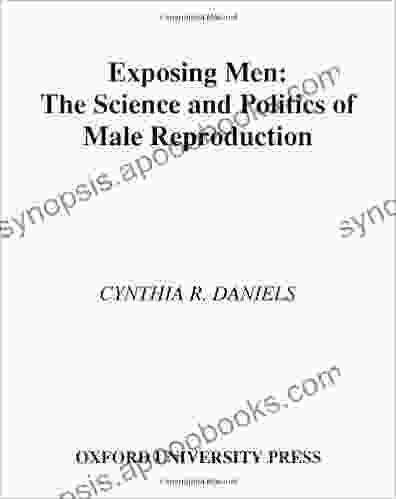The Science and Politics of Male Reproduction: A Comprehensive Guide

Male reproduction is a complex and fascinating biological process that has profound implications for individuals, societies, and the entire human race. This comprehensive guide delves into the science, politics, and social impact of male reproduction, providing a comprehensive overview for anyone seeking to understand this crucial aspect of human biology.
5 out of 5
| Language | : | English |
| File size | : | 2098 KB |
| Text-to-Speech | : | Enabled |
| Word Wise | : | Enabled |
| Print length | : | 272 pages |
| Lending | : | Enabled |
The Science of Male Reproduction
The process of reproduction begins with the production of sperm cells in the testes. Sperm cells are produced continuously throughout a man's lifetime, and each ejaculation contains millions of sperm. The sperm are transported through the epididymis and vas deferens into the penis, where they are ejaculated during sexual intercourse. The sperm then swim through the cervical canal and into the uterus, where they can fertilize an egg cell.
The fertilization of an egg cell by a sperm cell results in the formation of a zygote, which develops into an embryo and eventually a fetus. The developing fetus is nourished by the mother's body through the placenta, and it is born after approximately 9 months of gestation.
The human male reproductive system is regulated by a complex network of hormones. These hormones include testosterone, luteinizing hormone, and follicle-stimulating hormone. Testosterone is responsible for the development of male secondary sexual characteristics, such as increased muscle mass, facial hair, and a deep voice. Luteinizing hormone and follicle-stimulating hormone are responsible for the production of sperm cells.
The Politics of Male Reproduction
The politics of male reproduction are complex and often controversial. One of the most contentious issues is the use of assisted reproductive technologies (ARTs),such as in vitro fertilization (IVF) and intracytoplasmic sperm injection (ICSI). These technologies have made it possible for men with infertility to father children, but they have also raised concerns about the ethical and social implications of reproductive engineering.
Another controversial issue is the use of male contraception. Male contraception has been available for many years, but it is still not as widely used as female contraception. This is due in part to a number of factors, including social stigma, lack of awareness, and concerns about side effects.
The politics of male reproduction also extend to the workplace. In many countries, men are not entitled to paid paternity leave, which can make it difficult for fathers to bond with their newborns and participate in their care.
The Social Impact of Male Reproduction
Male reproduction has a profound impact on society. The number of children a man has can affect his status and power within his community. In some cultures, men are expected to have multiple children in Free Download to prove their virility and ensure the continuation of their family line. In other cultures, men are expected to limit their family size in Free Download to conserve resources.
The role of men in reproduction is also changing. In many countries, men are increasingly involved in the care of their children. This is due in part to changing social norms and the availability of paid paternity leave.
Male reproduction is a complex and fascinating process that has profound implications for individuals, societies, and the entire human race. This comprehensive guide has provided an overview of the science, politics, and social impact of male reproduction. By understanding these issues, we can better make informed decisions about our own reproductive health and the future of human reproduction.
5 out of 5
| Language | : | English |
| File size | : | 2098 KB |
| Text-to-Speech | : | Enabled |
| Word Wise | : | Enabled |
| Print length | : | 272 pages |
| Lending | : | Enabled |
Do you want to contribute by writing guest posts on this blog?
Please contact us and send us a resume of previous articles that you have written.
 Book
Book Novel
Novel Page
Page Chapter
Chapter Text
Text Story
Story Genre
Genre Reader
Reader Library
Library Paperback
Paperback E-book
E-book Magazine
Magazine Newspaper
Newspaper Paragraph
Paragraph Sentence
Sentence Bookmark
Bookmark Shelf
Shelf Glossary
Glossary Bibliography
Bibliography Foreword
Foreword Preface
Preface Synopsis
Synopsis Annotation
Annotation Footnote
Footnote Manuscript
Manuscript Scroll
Scroll Codex
Codex Tome
Tome Bestseller
Bestseller Classics
Classics Library card
Library card Narrative
Narrative Biography
Biography Autobiography
Autobiography Memoir
Memoir Reference
Reference Encyclopedia
Encyclopedia Eric Charry
Eric Charry Clemens Sedmak
Clemens Sedmak Eric M Anderman
Eric M Anderman Cynthia Sally Haggard
Cynthia Sally Haggard Colin Escott
Colin Escott Jean Alicia Elster
Jean Alicia Elster Hala Alyan
Hala Alyan Craig Murray
Craig Murray Patricia L Maclachlan
Patricia L Maclachlan Heavy D
Heavy D Hieu Minh Nguyen
Hieu Minh Nguyen Colin Yeo
Colin Yeo Hugh Mehan
Hugh Mehan Tracy K Smith
Tracy K Smith Maeve Binchy
Maeve Binchy Raia Prokhovnik
Raia Prokhovnik Creg Stephenson
Creg Stephenson D Nurkse
D Nurkse Wei Hui
Wei Hui Connie Johnston
Connie Johnston
Light bulbAdvertise smarter! Our strategic ad space ensures maximum exposure. Reserve your spot today!

 J.D. SalingerUnveiling the Dark Secrets of Petals on the Wind: A Chilling Journey into the...
J.D. SalingerUnveiling the Dark Secrets of Petals on the Wind: A Chilling Journey into the...
 Anthony WellsPlanning in the Public Domain: A Comprehensive Guide to Land Use Planning and...
Anthony WellsPlanning in the Public Domain: A Comprehensive Guide to Land Use Planning and...
 Reginald CoxUnveiling the Haunting History of the Hebrides in Wartime: A Literary Journey...
Reginald CoxUnveiling the Haunting History of the Hebrides in Wartime: A Literary Journey... Charles ReedFollow ·18.6k
Charles ReedFollow ·18.6k Eli BrooksFollow ·4.2k
Eli BrooksFollow ·4.2k Neil ParkerFollow ·7.4k
Neil ParkerFollow ·7.4k Bradley DixonFollow ·2.9k
Bradley DixonFollow ·2.9k D'Angelo CarterFollow ·5k
D'Angelo CarterFollow ·5k Doug PriceFollow ·12.3k
Doug PriceFollow ·12.3k Amir SimmonsFollow ·4.5k
Amir SimmonsFollow ·4.5k Jace MitchellFollow ·14.8k
Jace MitchellFollow ·14.8k

 Cooper Bell
Cooper BellKids Rule Box Office Hits for the Elementary Player
Empowering Young Performers:...

 Gabriel Blair
Gabriel BlairUnraveling the Enigma: Political Alienation and Its...
In the labyrinthine tapestry of human...

 Anthony Burgess
Anthony BurgessBe a Great Singer: Unleash Your Musical Talent with...
Do you dream of singing with...

 Heath Powell
Heath PowellDive into a Musical Masterpiece: "10 for 10 Sheet Music...
An Enchanting Journey Through Broadway...

 Guy Powell
Guy PowellUniversal Rights, Systemic Violations, and Cultural...
The notion of universal human rights is a...
5 out of 5
| Language | : | English |
| File size | : | 2098 KB |
| Text-to-Speech | : | Enabled |
| Word Wise | : | Enabled |
| Print length | : | 272 pages |
| Lending | : | Enabled |








